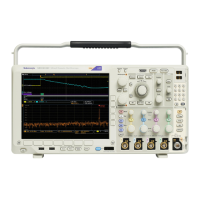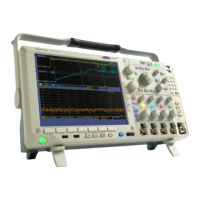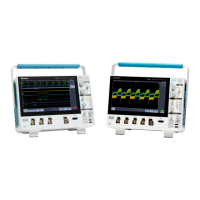Command Groups
Table 2-48: Waveform Transfer Commands (cont.)
Command
Description
WFMOutpre:PT_ORder?
This query returns the point ordering, which is always linear.
WFMOutpre:REFLEvel? This query returns the Reference Level of the outgoing waveform. It applies only to the four
frequency domain waveforms (RF Normal, RF Average, RF Max Hold, and RF Min Hold).
WFMOutpre:SPAN? This query returns the frequency span of the outgoing waveform. For non-MDO models, this
query always returns 0.0.
The span is the range of frequencies you can observe around the center frequency.
WFMOutpre:WFId? This query returns a string that describes several aspects of the acquisition parameters for
the source waveform, including Source, Coupling, Vertical Scale, Horizontal Scale, Record
Length and Acquisition Mode. If the waveform specified by DATa:SO Urce command is
not turned on, an error will be generated.
WFMOutpre:WFMTYPe? This query returns the type of the outgoing waveform. RF_FD indicates an RF frequency
domain waveform; RF_TD indicates an RF time domain waveform; ANALOG indicates
Channel 1–4 or the Math waveform. The default is analog. For non-MDO models, this
query always returns ANALOG.
The type of waveform that is being transferred in turn determines which window will display
it on the instrument screen: (the time domain window or frequency domain window).
WFMOutpre:XINcr? This query returns the horizontal point spacing in units of time (seconds), or frequency
(hertz) between data points in the waveform record transferred using the
CURVe? query.
This value corresponds to the sampling interval.
WFMOutpre:XUNit? This query indicates the horizontal units of the x-axis of the waveform record transferred
using the
CURVe? query. Typically, this value is "s" when the waveform source is displayed
in the time domain, and "Hz" when the waveform source is displayed in the frequency
domain. When the w aveform s ource is Math or a reference waveform, the value can be
"s" or "Hz".
WFMOutpre:XZEro? This query returns the time coordinate, in seconds, or frequency, in hertz, of the first data
point in the outgoing waveform record transferred using the
CURVe? query. This time or
frequency is relative to the time of the trigger, which is always 0. Thus, the XZEro time or
frequency can be negative.
WFMOutpre:YMUlt? This query returns the vertical scale multiplying factor used to convert the waveform data
point values in the outgoing waveform record from digitizing levels to the YUNit units. You
can determine the units by using the
WFMOutpre:YUNit query.
See the description of the WFMInpre:YMUlt command to see how this scale factor is used to
convert waveform sample values to volts.
WFMOutpre:YOFf? This query returns the vertical position of the source waveform in digitizing levels. There are
25 digitizing levels per vertical division for 1-byte data, and 6400 digitizing levels per vertical
division for 2-byte data. See the description of WFMInpre:YOFf to see how this position is
used to convert w aveform sample values to volts.
WFMOutpre:YUNit? This query returns the units of data points in the outgoing waveform record transferred
using the
CURVe? query. This can be any of several string values, depending upon the
vertical units of the source waveform (specified by the DATa:SO Urce command). Typically,
this is “V” for volts.
WFMOutpre:YZEro? This query returns the vertical offset of the s ource waveform. You can determine the units
using the WFMOutpre:YUNit? query. See the description of WFMInpre:YZEro to see how
this offset is used to convert waveform sample values to volts.
MDO4000/B/C, MSO/DPO4000B and MDO3000 Series Oscilloscopes Programmer Manual 2-109

